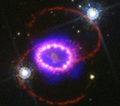Supernovae:
Supernovae (SNe) come in two types: core-collapse
and thermonuclear. From an observational (and historical) point of view,
the thermonuclear SNe have been named Type Ia, whereas all other types
(Types Ib, Ic, II and IIb) are now understood to be core-collapse events.
Core-collapse SNe stem from stars originally weighing more than roughly
8 times more than the Sun. The final fate of the star's core is a contraction
to a neutron star or a black hole, whereas the outer parts of the star
is thrown off at very high velocities. There is yet no exact explanation
to how the shock following the core contraction can remove the outer envelope,
but it seems clear that the copious production of neutrinos at core collapse
is crucial for a successful explosion. That core-collapse SNe mainly produce
energy in the form of neutrinos was confirmed by the observed neutrinos
from SN 1987A by two independent neutrino telescopes. One of these observations
resulted in the Nobel Prize in Physics in 2002. Core-collapse
SNe are probably also responsible for at least a fraction of all gamma-ray
bursts.
The origin of thermonuclear SNe is less understood. Although it
seems without doubt that a thermonuclear SN (SN Ia) involves the explosion
(and most likely the complete disruption) of a white dwarf in a binary
system, it is not yet clear what is the nature of the binary companion.
It could be another white dwarf, or it may be a less evolved star. In
the scenario with two white dwarfs they coalesce and explode, whereas
in the other scenario the white dwarf accretes matter from its companion
and explodes when the mass excedes the Chandrasekhar mass (roughly 1.4
solar masses). It may be that both scenarios exist, and contribute to
the observed SNe Ia. The fact that most SNe Ia seem so similar in terms
of observational characteristics have made them ideal to use as cosmological
yardsticks. However, to make full use of them for this purpose probably
requires to reveal their true nature, and the project described here
is one possible way to do so.
Supernova remnants:
A supernova remnant (SNR) is the expanding debris from a supernova explosion, as well as the matter swept up by the debris. The transition between supernova and SNR is somewhat arbitrary, but a good dividing line is when the observed emission is no longer mainly powered by radioactive decay, but by ejecta interaction with interstellar gas, or by pulsar activity. (Interaction with circumstellar gas is possible also at early phases of a supernova remnant, but this may dominate the emission also from supernovae already shortly after the explosion. One such supernova event was SN 1994W) An example of a pulsar-powered SNR is the Crab SNR, whereas an example of a shock dominated SNR is Cas A (see also here).
Last updated - December 8, 2002